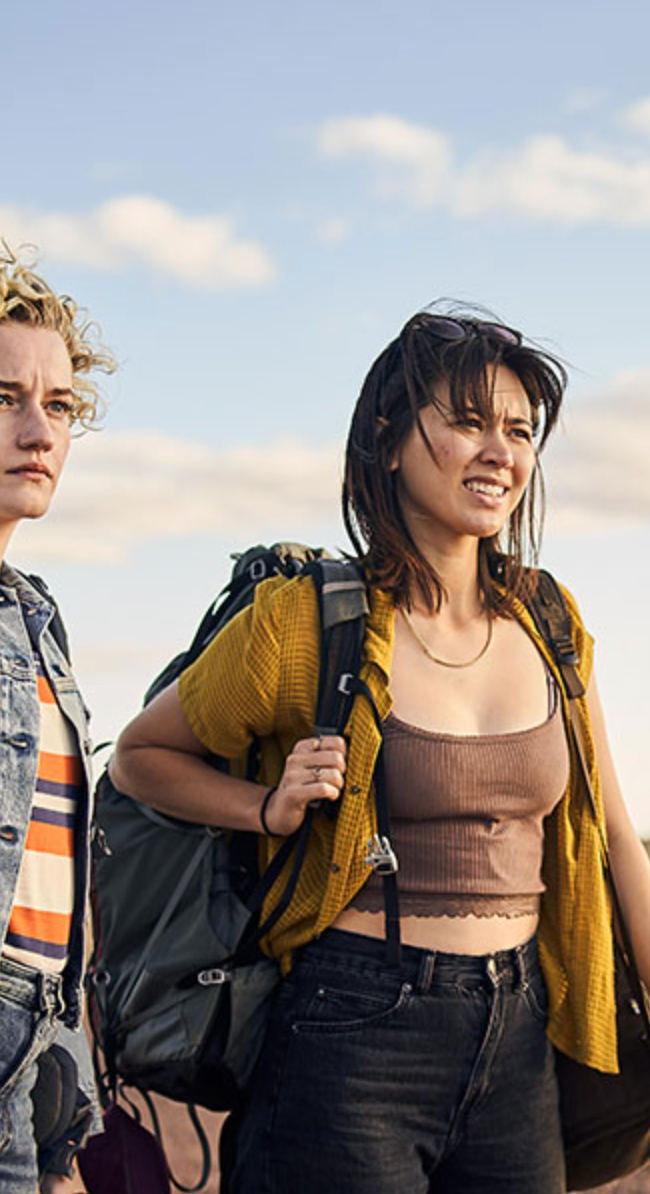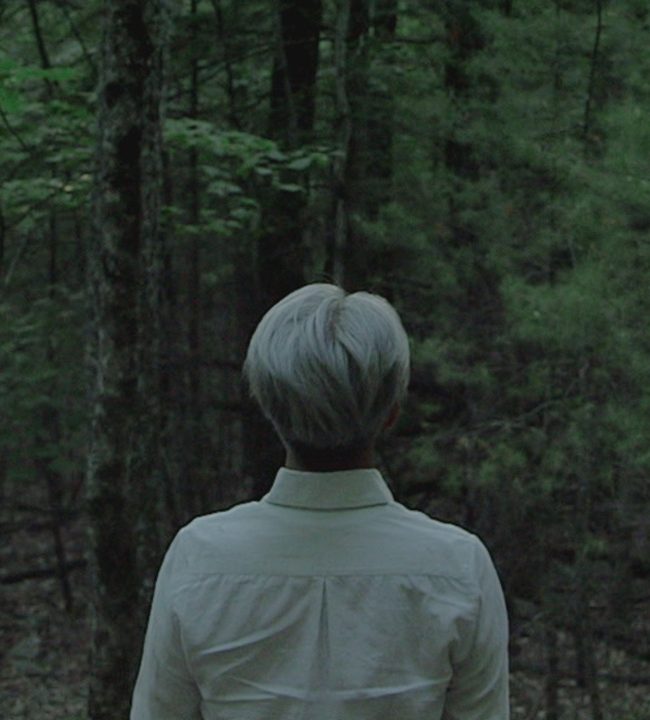A Conversation with Gabrielle Brady (ISLAND OF THE HUNGRY GHOSTS)
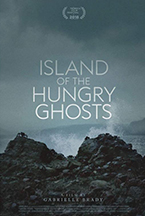 I met with Australian director Gabrielle Brady on Saturday, April 21, at the 2018 Tribeca Film Festival, to discuss her debut feature documentary Island of the Hungry Ghosts (which I also reviewed, and which won the festival’s Best Documentary Feature Jury Award). The film profiles life on Christmas Island, an Australian territory in the Indian Ocean, focusing on a trauma counselor, Poh Lin, and her family, and on the red crabs that have populated the place for eons. Humans have made the island their home for less than 100 years, and the rugged, volcanic-rock beaches to which Brady cuts, time and again, remind us of our primordial origins. The island’s top-secret detention center for asylum seekers uses Poh Lin to help its refugees work through the experience that brought them there, but her intermittent contact with the detainees leads to frustrating results for both sides. Meanwhile, the crabs march onward, migrating across the island, navigating roads but recently built. Together, the separate story threads weave an evocative tapestry of metaphysical meaning. Here is a condensed digest of our conversation, edited for length and clarity.
I met with Australian director Gabrielle Brady on Saturday, April 21, at the 2018 Tribeca Film Festival, to discuss her debut feature documentary Island of the Hungry Ghosts (which I also reviewed, and which won the festival’s Best Documentary Feature Jury Award). The film profiles life on Christmas Island, an Australian territory in the Indian Ocean, focusing on a trauma counselor, Poh Lin, and her family, and on the red crabs that have populated the place for eons. Humans have made the island their home for less than 100 years, and the rugged, volcanic-rock beaches to which Brady cuts, time and again, remind us of our primordial origins. The island’s top-secret detention center for asylum seekers uses Poh Lin to help its refugees work through the experience that brought them there, but her intermittent contact with the detainees leads to frustrating results for both sides. Meanwhile, the crabs march onward, migrating across the island, navigating roads but recently built. Together, the separate story threads weave an evocative tapestry of metaphysical meaning. Here is a condensed digest of our conversation, edited for length and clarity.
Hammer to Nail: So, this is your first feature, but you had previously made a short film called The Island, in 2017, which was also set on Christmas Island. Could you talk about how you found this subject and about your choice to make both the short film and then the feature.
Gabrielle Brady: Actually, I first arrived on the island as a tourist. I was living in Indonesia, at the time, and Poh Lin, who is featured in the film, is actually a very good friend of mine. So, I was going across for a holiday, and during my visit, we spent the time diving, and at the beach, and it was a real holiday experience. The island, as much as it has this dark side, it’s also incredibly beautiful. So, I spent the time, as a tourist, making my way and investigating the island.
On the very last day that I was there, Poh Lin said to me, “I need to show you something.” And we drove up, into the jungle, and she had this huge machete, and we started cutting our way through the jungle. I had no idea where we were going, and at the end of this hour-long journey was this huge detention center. In that moment, it was chilling to imagine that the people she was working with were inside this place. I mean, it really looks like a prison, and it looks like it’s been built to be hidden; it’s in the middle of the jungle.
In that moment, a seed started to grow of what it would look like if we started collaborating on making something in this place. I think, for me, it was also the contrast of the place. I mean, at that time, the migration of the crabs was beginning. So, I had textures and I had a bit of a taste of some of these really stark contrasts that sit in the island, and it stayed with me. It started haunting me. I would keep going back and visiting Poh, and then the idea of the film grew from that.
HtN: So, is the short film about similar subjects? How different is the short from the feature, in terms of its story?
GB: So, the short film The Island was actually commissioned through The Guardian, and that came as a production strategy, as well, of “How can we make this feature film? Maybe we could also make a shorter film alongside of it.” Which, for me, was incredible, because it was a creative testing ground, to see what would people take from this story, how will it be received, how will I approach the material. And also, we shot a lot of material. (laughs) I fell in love with a lot of elements on the island, so it also meant I could make two films out of the same material. That was really exciting, as a director.
So, the short film was really in the same vein as the feature. And Poh Lin is also in the short film, but the short film is for an online audience. So, in the short film, we’re giving a lot more to people; we’re giving a lot more context. Poh Lin’s talking directly to the camera. We don’t kind of play on the mystery so much in the short film.
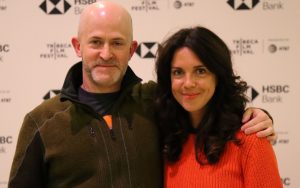
Our Chris Reed and filmmaker Gabrielle Brady
HtN: That’s really interesting, especially since I wanted to talk about your choice to make a purely observational film, in which you provide no context about either the island or the detention center, or the crabs, except what we glean from listening to people talk. And you just told me that the short film is all about the context. So, explain your decision for the feature. I found it fascinating, but explain your decision to make the feature in that way.
GB: Oh, that’s such a good question. I’m going to try and condense it, because it’s a huge one. I think, for me, stylistically, as a director, I’m really fascinated by observation and not having too much intrusion, or feeling of intrusion. But I’m also interested in hybrid filmmaking, performative elements.
And so, from the beginning, particularly with this film, since it has such a political storyline – a topic that’s being discussed a lot, in a lot of different forms and a lot of different ways – for me, it was…You know, I came to the film, meeting the people that Poh Lin is working with and being incredibly moved by what they’re going through, and having Poh Lin as a very close friend – we’ve been friends for 10 years – and being a witness to what she was experiencing…But also, it was the island, the atmosphere of this place was so heavy.
I’m someone who’s drawn to locations, and them I’m drawn to stories. So, for me, it was a sensorial experience, being on the island. Walking through the jungle, peeking at the blowholes and having these explosions of sound, alongside hearing these stories of what was happening in the detention center, was what was moving me so deeply. So, for me, it was never a question that we would have so much information, and I think there are a lot of reasons for that.
One is that I didn’t want to ever create a refugee film. When I say that, I mean one that has a traditional storyline of following somebody’s journey, and it’s a one-person story, and I felt that there are a lot of films that explore that, at this moment. And then another reason is I wanted to make a film about an island, about a place and a kind of moment in time. So, the decision around the observational was that we, as people watching the film, become a witness to what’s happening, as Poh Lin is a witness to what’s happening.
And this is the thing: nobody’s seeing this. Poh Lin had no one around her knowing what was going on on the island. It’s incredibly secretive, what’s happening in that place. And so, one of the strategies was, if we’re observers, and we’re privy to this really intimate world, we’re kind of then taken in, like Poh Lin is. And I kind of wondered what that experience would be for people to be taken into the story intimately. And for me, I enjoy stories where I’m piecing together the pieces. I’m gleaning and I’m taking the essence from this and that and making connection out of it, and that’s when we start to really think, and that’s when we start to really feel.
HtN: One of the things that I noticed in the film, and you can tell me if this was intended or not, is that we see so much of the red crabs and their protected migration – although we also see red splotches on the road where people were not so protective – and they have this institutional bureaucracy that helps them across, which is in sharp contrast to the way the same institutional bureaucracy treats the human refugees. Was this your goal, all along, to juxtapose the red crabs and the migrant crisis?
GB: One of the first things that really struck me when I was on the island was, of course, the crabs. Being in the jungle and having a kind of river of red, it was such a strange and bizarre sight. There was something kind of beautiful and epic, but also a little bit dark and creepy. And so, it was kind of already setting a real atmosphere for me. And then, being privy to the migration of the crabs, it kind of opened up the whole feeling of it, for me. It’s one of the oldest animal migrations on earth; it’s been happening on this island for hundreds of thousands of years.
HtN: And people have only lived on this island, according to your film, for less than a hundred years, correct?
GB: That’s exactly right. It’s one of the last discovered places on earth, in terms of human contact. So, there’s already this kind of huge contrast, in terms of before humans and after humans. You have these 50 million red crabs – in years gone by, it was a lot bigger number – moving their way down from the jungle to the ocean, and at the same time, this stasis, where people are forced to stay in limbo, where they can’t move, and that was incredibly visible. It was just very present, from the beginning.
Actually, what I was most conscious about was not creating too much of a dichotomy. Because, of course, the film could have just been that dichotomy: “Oh, look, we’re caring for the crabs, and we don’t care for the humans.” Yeah, it’s implicit in the film, and of course there are scenes that talk to that, but it was really important to me that it not just get locked into that dichotomy, because that’s also too easy. But yes, absolutely, the metaphor of the crabs was one of the first moments that I knew that I could make a film out of this.
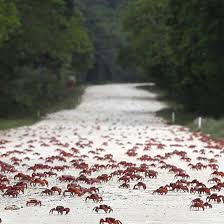
HtN: The crabs are incredibly beautifully photographed, as is that rocky seashore, which looks volcanic. I can’t imagine filming on that inhospitable rocky landscape. Some of it you did through drones, it seems, but somebody had to be standing there with a camera. You also have some intense close-ups of the crabs, so somebody had to be standing in some really uncomfortable areas. Can you talk about those challenges and the filming process?
GB: Actually, we didn’t use any drones. So, we were actually a really small team, and we had a really small budget, especially to begin with, and the film team was essentially just myself, the DOP [director of photography] Michael Latham, and the sound recordist, Leo Dolgan. We were really kind of guerilla-style. I mean, Michael and I had spoken a lot, before we went to the island, about how we wanted to film the different stories and how the feeling of that would contrast. So, we spent a lot of time preparing, and we knew that we wanted to track through the jungle and have a feeling of almost the eye of the jungle watching … you know, the eye of the island watching what was happening, at every moment. But how we were going to do that was still a complete mystery until we got to the island.
You know, this is a really remote location and it’s really difficult to get to, and so we just decided that we would just make it work when we were there. (laughs) So, we arrived with our gear, and we went down to the local hardware store, and asked if they had a painter’s truss. We took the painter’s truss and we got some kind of wheels off some old roller skates and we built ourselves a dolly, and then we’d have to lug the dolly at every location, because everywhere we wanted to shoot just happened to be at the furthest end of the island, with the most arduous journey to get there. So … (laughs) … there were some really dicey moments. And we’re covered in mosquitoes the whole time, and especially with the migration of the crabs, that was an overnight shoot, and by the morning, we were just absolutely exhausted. But we were real workhorses. It was just a really physical shoot.
HtN: Well, you can feel that. There’s a palpable sense of that arduousness. I’m just curious: what camera, or cameras, did you shoot on?
GB: We shot on the ARRI Alexa Mini. Michael uses that a lot for his work, and I wanted the film to feel, in its texture, like a fiction, and we wanted to have an image that felt cinematic, that this was a film to play in the cinema. But by the same token, we were shooting a documentary, so we needed to be on our toes, we needed to be in intimate spaces. So, the Alexa Mini was amazing, because it’s small enough for Michael to carry and to have on the shoulder for a period of time, and the image is just so beautiful.
HtN: So, now that I know you are close friends with Poh Lin, I don’t question how you got access to her and her family. I find the bilingual nature of her family very interesting, by the way. I do have a question about access to the detainees, however. Many of them don’t feel empowered about any aspect of their life. How did you negotiate their permissions to be on camera?
GB: That’s a really important question. You know, the film took 4 years to make, and a huge part of that was ethics and permissions. So, from the very beginning, when we’ve gone back to the island and we’ve started meeting with people, at that stage people were given day trips outside the detention center, one-off day trips. I would go along with Poh Lin on these day trips and begin to meet people and get a sense if anybody wanted to be filmed, or how that would work. But at the time, it felt so risky to be filming. It was a really precarious environment, not just for Poh Lin, but also for the other people in the film.
So, the therapy room is actually away from the detention center. It’s near the local hospital, and people are brought in. During the research phase, we were doing filming, of course. People would come in, and we had met with people over time…and then they would go back into the detention center. It was really…how were we going to keep in touch with people to know we had real permission? Real permission isn’t a piece of paper. Real permission is an ongoing conversation: it’s knowing that people know exactly what they’re getting into.
So, in the film, we have some of those recordings, and we were able to get in touch with people, but we also filmed some of the therapy sessions on the mainland, just after people had arrived. Doing it this way meant that we could ensure safety. And even now, during the edit period, people watched their part. We had conversations to understand what they thought about it. We also filmed with a lot of people, and the reason for that was that we knew that there were people who would be unable to be in the film. We wanted to make sure that, at any point, if somebody said “I can’t do this,” that it wasn’t pinning on them, because this is a really vulnerable situation they’re in.
So, that was one part. As far as the intimacy of the therapy scenes, Poh Lin had a rule, and that was basically: therapy #1, filming #2. We were there as a fly on the wall. This was a really observational space, and if were asked to leave, we would have to leave. Not that we were, but that was the rule. Basically, it was a therapy session, and we were there filming it. That’s what maintained the intimacy, but also the ethics of what we were doing.
HtN: Final question! So, you talked earlier about your love of hybrid techniques and hybrid docs. There’s a moment in your film, right after Poh Lin has talked about what happens to people when the only freedom they’re given is freedom over their body. We’ve just heard, at that point, about somebody self-harming. And she approaches the end of a pier, and then suddenly, she’s in the water, as if she’s drowning…a staged moment. It recalls a little bit the 1957 Russian film The Cranes Are Flying. I don’t know if you’re familiar with it?
GB: Yes! I love that film! (laughs) Thank you for saying that!
HtN: So, it recalls for me that moment in the film where Veronika throws herself onto the train tracks, but it’s all in her imagination. Could you talk about your motivation for that? It’s the one moment where it’s clear that there’s an artifice of cinema at work.
GB: So, that was really borne out of…Poh Lin and I were doing a lot of, apart from the observational scenes, with the family and the actual happenings. We were also doing some performative work, as well. So, this would really involve a range of things. It would involve collating her dreams. We would have writings. We would have sessions where we were trying to draw out a little bit more of the experience, and I think because the experience, for her, was so internal, for so long, a huge part of the process was: “How do we visualize that? How do we take people inside of your experience and the inner landscape of Poh Lin? How do we go deeper with you?”
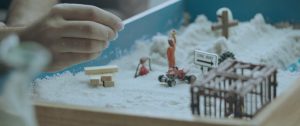
And so, that scene was really borne out of that idea. It came from a recurring dream that Poh Lin was having on the island, when things were really not going well. And so, she had this work, and told me about the dream, and I took it away and I scripted something, and then we took it down, and then she took that and just went with it. It was a collaboration, that scene, and for me, it also tells people that we’re diving into someone’s inner psyche. We’re moving outside the traditional doc realm. So, it was important for me to have elements like this in the film.
HtN: Well, thank you very much. It’s a really beautiful film. I enjoyed watching it. Congratulations on completing it.
GB: Thanks so much for the chat!
– Christopher Llewellyn Reed (@ChrisReedFilm)








